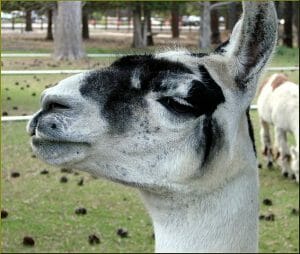Head Definition
The head is the part of most animals, located at one end of the body, which contains the highest density of neurons, and often other sense organs. In humans, the head contains the brain, which is encased in a protective skull, and the eyes, ears, nose, and mouth.
The image below shows the head of llama. The eyes, ears, nose, and mouth are clear. The brain is found within the skull, which is between the llama’s ears.
The head is thought to have evolved through a process called “cephalization.” This term derives from “kephalo” for “head.” It is thought that the clustering of nerves close together enables faster and more complex processing of information.
This gives organisms advantage by allowing them to respond faster and more intelligently to their environments. As a result, over time neurons tend to become clustered close to one end of an organism.
Having sense organs near the animal’s nerve center also improves reaction time by allowing impulses from these sense organs to reach the brain almost instantaneously after perception.
Vertebrates like humans, invertebrates such as insects, and complex members of the animal group called “invertebrate chordates” which have neither spinal cords nor exoskeletons, all tend to have heads where a large cluster of neurons is bordered by sense organs.
Function of the Head
The head typically serves as the information processing center of the animal. Information from the sense organs and the body is relayed to the brain, which is the nerve center found in the heads of complex life forms.
Even very simple organisms often have a point where their nerves concentrate, along with any cells they may have such as photoreceptors.
The brain can process information about the environment to make decisions, store memories and skills, and make changes to the animal’s behavior and emotional states.
The head also often contains the primary organs for vision, hearing, smell, taste, and in some organisms, antennae.
Examples of Heads
Humans
The human head contains the brain, eyes, ears, nose, and mouth. The front of the head, which is hairless and contains the eyes, nose, and mouth, is referred to as the face.
The human brain is tuned to recognize small differences in the bone structure of the human head, allowing humans to recognize other individuals based on their facial features.
Bees
Like humans, the head of a bee contains two eyes and a mouth that’s used for tasting and ingesting food. However, the bee also has antennae, which are sensory organs that humans don’t possess.
Antennae are very sensitive to vibration, and also to pheromones, which are chemical signals put out by other insects.
This is an example showing that even when organisms do not have the same sensory organs, they still tend to cluster their sense organs near the brain for efficient processing.
Hydras
Hydras are very simple aquatic organisms that have neither skeletons nor exoskeletons. Hydras are thought to be a very old species, having first appeared long before the evolution of the body structure seen in most animals.
But even hydras have something that could be called a head; on one end of their bodies, a cluster of nerves and light-sensitive cells serve as primitive “eyes” and information processing center.
Quiz
1. Why do most animals have a head?
A. Because having a central nerve cluster allows them to process information faster, and make more complex calculations.
B. Because having sense organs located close to the brain allows for faster reaction time.
C. Because organisms that can process information faster have a survival advantage.
D. All of the above.
2. Which of the following is NOT part of the human head?
A. Brain
B. Eyes
C. Ears
D. None of the above
3. Which organisms would you NOT expect to have a head?
A. Insects
B. Vertebrates
C. Simple aquatic organisms
D. None of the above.
References
- Cobb, J. B. (2009). Back to Darwin: a richer account of evolution. Cambridge: International Society for Science and Religion.
- Wake, M. H. (1979). Hyman’s Comparative Vertebrate Anatomy (3rd ed.). Chicago and London: The University of Chicago Press.
Head

No comments:
Post a Comment